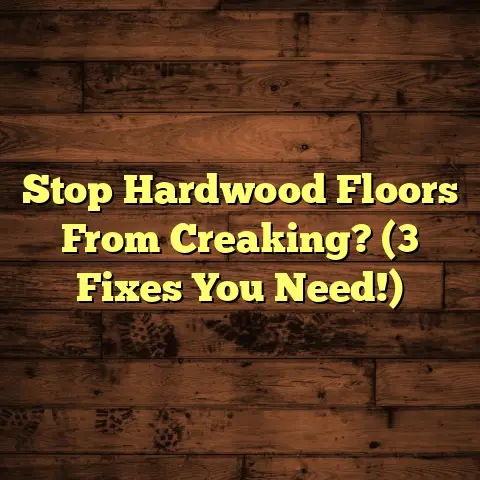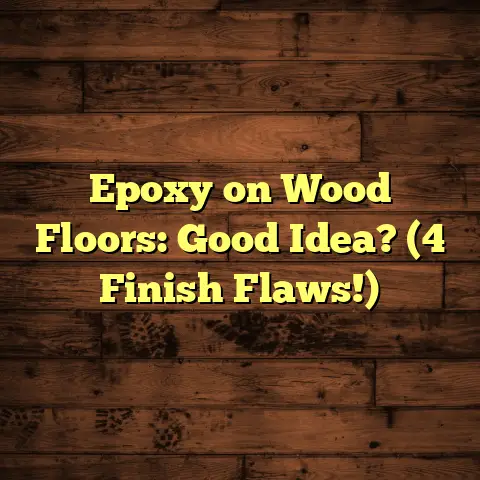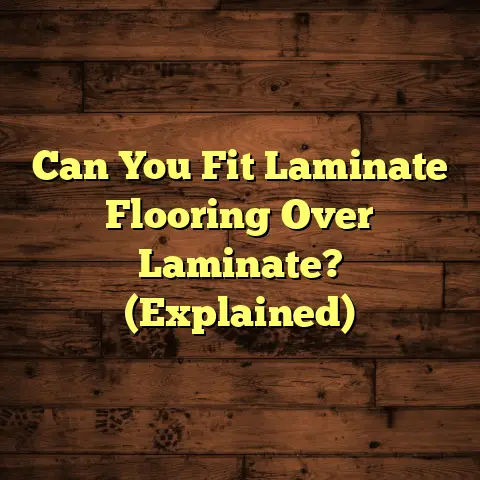Embossed Vs Textured Vinyl? (5 Differences REVEALED!)
What if you could transform your living space with flooring that not only enhances the aesthetic appeal but also meets your functional needs?
Imagine stepping into a home where every room reflects your style, from the kitchen to the bathroom.
As you explore your options, you come across two popular choices: embossed vinyl and textured vinyl.
At first glance, they seem similar, but as you delve deeper, you realize that these two types of vinyl flooring hold distinct characteristics that could significantly impact your home renovation project.
Which one will you choose? Let’s dive in and uncover the secrets!
Section 1: Understanding Vinyl Flooring
Vinyl flooring has exploded in popularity, and for good reason. I’ve seen it transform countless homes, and its appeal lies in its durability, versatility, and relatively affordable price point.
It’s a fantastic option for homeowners who want a stylish look without breaking the bank.
Within the vinyl family, you’ll find a wide range of options, including sheet vinyl, vinyl tiles, and luxury vinyl planks (LVP).
Embossed and textured vinyl fall under this umbrella, each offering unique aesthetic and functional qualities.
But what exactly sets them apart?
That’s where the texture comes in. Texture in flooring isn’t just about how it feels underfoot; it plays a crucial role in the overall look and feel of a space.
It can add depth, create visual interest, and even enhance the safety of your floors.
Think about it: a smooth, glossy floor might look sleek, but it can also be slippery.
A textured surface, on the other hand, can provide better grip and prevent accidents.
Section 2: Definition and Characteristics of
Embossed Vinyl
So, what exactly is embossed vinyl?
In my experience, it’s all about creating a raised pattern on the surface of the vinyl.
The manufacturing process involves pressing a design onto the vinyl layer, creating a three-dimensional effect.
This technique allows manufacturers to mimic the look of natural materials like wood, stone, or tile with incredible realism.
I’ve seen embossed vinyl that looks so much like real hardwood, you’d swear it was the real deal!
And that’s the beauty of it – you get the aesthetic appeal of natural materials without the high cost and maintenance.
Embossed vinyl comes in a huge variety of designs and styles.
Whether you’re going for a rustic farmhouse look or a modern, minimalist vibe, there’s bound to be an embossed vinyl option that fits your vision.
I’ve installed everything from embossed wood planks with realistic grain patterns to embossed stone tiles that look like they were quarried straight from the earth.
The possibilities are endless!
The key benefit of embossed vinyl is its ability to replicate the look and feel of natural materials.
It’s also more practical. It’s water-resistant, scratch-resistant, and easy to clean, making it a great choice for high-traffic areas like kitchens, bathrooms, and entryways.
Section 3: Definition and Characteristics of
Textured Vinyl
Now, let’s talk about textured vinyl.
While embossed vinyl focuses on creating raised patterns, textured vinyl is more about the overall surface finish.
The manufacturing process involves adding a specific texture to the vinyl layer, which can range from subtle matte finishes to more pronounced grain patterns.
Unlike embossed vinyl, textured vinyl doesn’t necessarily mimic a specific material.
Instead, it focuses on creating a tactile surface that adds depth and visual interest.
I’ve worked with textured vinyl that has a lightly stippled surface, providing a subtle grip underfoot, as well as vinyl with a more pronounced texture that resembles the feel of natural stone.
The types of textures you’ll find in vinyl flooring are diverse.
Matte finishes are great for reducing glare and creating a softer, more understated look.
Satin finishes offer a slight sheen, adding a touch of elegance to the space.
Gloss finishes are the most reflective, creating a high-end, luxurious feel.
And then there are specialized textures like wood grain, stone, and even fabric-like patterns.
One of the unique properties of textured vinyl is its slip resistance.
The textured surface provides better traction, making it a safer option for areas where slips and falls are a concern.
I often recommend textured vinyl for bathrooms, kitchens, and entryways, especially in homes with young children or elderly residents.
The texture also affects how the floor feels underfoot.
A lightly textured surface can feel softer and more comfortable than a completely smooth one.
And in high-traffic areas, the texture can help to distribute weight and reduce fatigue.
Section 4: Five Key Differences Between
Embossed and Textured Vinyl
Alright, let’s get down to the nitty-gritty. What are the five key differences between embossed and textured vinyl?
Having worked with both types for years, I can tell you that understanding these differences is crucial for making the right choice for your home.
1. Visual Appeal
The visual appeal of embossed vinyl lies in its ability to replicate natural materials.
The raised patterns create depth and dimension, making it look remarkably like real wood, stone, or tile.
I’ve seen embossed vinyl transform a basic kitchen into a stunning, high-end space simply by mimicking the look of expensive stone flooring.
Textured vinyl, on the other hand, is more about creating a subtle, tactile surface.
The texture can add visual interest and depth, but it doesn’t necessarily try to replicate a specific material.
Instead, it focuses on creating a unique look that complements the overall design of the space.
I find that textured vinyl works well in modern or minimalist settings where the goal is to create a clean, understated look.
These differences can significantly influence the overall ambiance of a space.
Embossed vinyl tends to create a more traditional, classic feel, while textured vinyl can add a modern, contemporary touch.
2. Feel and Comfort
The tactile differences between embossed and textured vinyl are noticeable underfoot.
Embossed vinyl, with its raised patterns, can feel more pronounced and defined.
I’ve had clients who love the feeling of walking on embossed wood planks because it mimics the texture of real wood.
Textured vinyl, with its more subtle surface finish, tends to feel smoother and more consistent.
It can be a great option for those who prefer a softer, more comfortable feel underfoot.
Different textures can influence the overall perception of warmth and coziness in a room.
For example, a textured vinyl with a wood grain pattern can create a sense of warmth and comfort, while a smooth, glossy vinyl might feel cooler and more modern.
3. Durability and Maintenance
In terms of durability, both embossed and textured vinyl are excellent choices for high-traffic areas.
However, there are some subtle differences to consider.
Embossed vinyl, with its raised patterns, can sometimes be more susceptible to wear and tear, especially if the embossing is very deep.
I’ve seen cases where the edges of the embossed patterns can start to wear down over time, particularly in areas with heavy foot traffic.
Textured vinyl, with its more consistent surface, tends to be more resistant to wear and tear.
The texture helps to distribute weight and reduce the impact of foot traffic, making it a longer-lasting option.
As for maintenance, both types of vinyl are relatively easy to clean.
However, embossed vinyl can sometimes require a bit more attention.
The raised patterns can trap dirt and debris, so it’s important to sweep or vacuum regularly and occasionally use a damp mop to clean the surface.
Textured vinyl is generally easier to clean because the surface is more uniform.
A quick sweep or mop is usually all it takes to keep it looking its best.
4. Installation Process
The installation process for embossed and textured vinyl is generally similar.
Both types can be installed as sheet vinyl, vinyl tiles, or luxury vinyl planks (LVP).
However, there are a few subtle differences to keep in mind.
Embossed vinyl, with its raised patterns, can sometimes be more challenging to install, especially if you’re working with large sheets or intricate designs.
It’s important to ensure that the patterns line up correctly and that the seams are seamless to create a professional-looking finish.
Textured vinyl, with its more uniform surface, is generally easier to install.
The sheets or planks tend to lay flat more easily, and the seams are less noticeable.
The choice of flooring can influence the ease or complexity of installation.
If you’re a DIY enthusiast, you might find textured vinyl to be a more forgiving option.
However, if you’re working with a complex design or a large area, it’s always best to hire a professional installer to ensure a flawless finish.
5. Cost and Value
The cost of embossed and textured vinyl can vary depending on the quality, design, and brand.
However, in general, embossed vinyl tends to be slightly more expensive than textured vinyl.
This is because the embossing process adds an extra layer of complexity to the manufacturing process.
The overall value proposition of each type depends on your individual needs and preferences.
Embossed vinyl offers the aesthetic appeal of natural materials at a fraction of the cost.
It’s a great option for those who want to create a high-end look without breaking the bank.
Textured vinyl offers a more subtle, modern look with excellent durability and slip resistance.
It’s a great option for those who prioritize functionality and safety.
Market demand can also affect pricing.
If a particular style or design of embossed vinyl is in high demand, the price may be higher than a less popular textured vinyl option.
Section 5: Real-Life Applications and Use Cases
Let’s take a look at some real-life examples of how homeowners and designers have used embossed and textured vinyl in their projects.
I worked on a kitchen remodel where the homeowner wanted to create a rustic farmhouse look.
We chose embossed vinyl planks that mimicked the look of reclaimed wood.
The embossed texture added depth and character to the floor, making it look like it had been salvaged from an old barn.
The homeowner was thrilled with the result, and the floor became the focal point of the entire kitchen.
In another project, I helped a client design a modern bathroom.
We opted for textured vinyl tiles with a matte finish.
The subtle texture added a touch of visual interest without overwhelming the space.
The client loved the clean, minimalist look and appreciated the added slip resistance in the bathroom.
These examples highlight how the choice of flooring can impact the overall design of the space and the satisfaction of the homeowners.
By carefully considering the visual appeal, feel, durability, installation process, and cost of embossed and textured vinyl, you can make the right choice for your home.
Conclusion: Summarizing Key Takeaways
So, there you have it – the five key differences between embossed and textured vinyl flooring.
Let’s recap:
- Visual Appeal: Embossed vinyl mimics
natural materials, while textured vinyl
focuses on creating a subtle, tactile
surface. - Feel and Comfort: Embossed vinyl can feel
more pronounced, while textured vinyl tends
to feel smoother. - Durability and Maintenance: Textured
vinyl tends to be more resistant to wear
and tear, while embossed vinyl may require
more attention to cleaning. - Installation Process: Textured vinyl is
generally easier to install than embossed
vinyl. - Cost and Value: Embossed vinyl tends to
be slightly more expensive than textured
vinyl.
Understanding these differences is crucial when making a flooring choice for your home renovation project.
Consider your personal style, functional needs, and the specific requirements of your space when choosing between embossed and textured vinyl flooring.
Final Thoughts: Call to Engage
Now I’d love to hear from you!
What are your thoughts on embossed and textured vinyl flooring?
Have you used either of these options in your home?
What was your experience?
Share your thoughts, experiences, and preferences in the comments section below.
Let’s start a conversation and help each other make informed decisions about our flooring choices!





